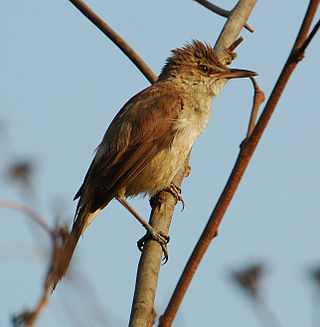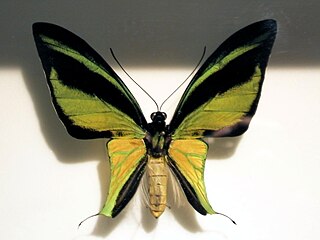
The smooth newt, European newt, northern smooth newt or common newt is a species of newt. It is widespread in Europe and parts of Asia, and has been introduced into Australia. Individuals are brown with a spotted underside that ranges in color from orange to white. They reach an average length of 8–11 cm (3.1–4.3 in); males are larger than females. The newts' skins are dry and velvety when they are living on land, but become smooth when they migrate into the water to breed. Males develop a more vivid colour pattern and a conspicuous skin seam (crest) on their back when breeding.

The clamorous reed warbler is an Old World warbler in the genus Acrocephalus. It breeds from Egypt eastwards through Pakistan, Afghanistan and northernmost India to south China and southeast Asia. A. s. meridionalis is an endemic race in Sri Lanka.

The New Zealand kākā is a large species of parrot of the family Nestoridae found in New Zealand's native forests. The species is often known by the abbreviated name kākā, although it shares this name with the recently extinct Norfolk kākā and Chatham kākā. Two subspecies of New Zealand kākā are recognised. It is endangered and has disappeared from much of its former range, though the re-introduction of North Island kākā at Zealandia in Wellington has led to an increasing population of the birds across the city.

The savanna hawk is a large raptor found in open savanna and swamp edges. It was formerly placed in the genus Heterospizias. It breeds from Panama and Trinidad south to Bolivia, Uruguay and central Argentina.

Notophthalmus meridionalis, the black-spotted newt or Texas newt, is a species of aquatic newt native to northeastern Mexico and southern Texas in the United States. This amphibian was put on the IUCN Red List of Endangered Species in 2008 with populations still decreasing. It was reclassified to Vulnerable in 2022.

Ornithoptera meridionalis, the southern tailed birdwing, is the smallest species of the genus Ornithoptera. It is known from a handful of localities in southeast Papua, New Guinea and several localities along the south coast of Irian Jaya.
The Isla De La Juventud tree hutia or southern hutia is a subspecies of rodent in the subfamily Capromyinae. It is endemic to lowland moist forests on Isla de la Juventud in Cuba. It is threatened by habitat loss and is considered Critically Endangered by the IUCN Red List.

The southern lesser bamboo lemur, also known as the southern bamboo lemur, rusty-gray lesser bamboo lemur, and southern gentle lemur, is a species of bamboo lemur endemic to southern Madagascar.

The southern woolly lemur, or southern avahi, has been recently recognized as a separate species of woolly lemur in 2006 by Zaramody et al. It is a nocturnal and pair-living species. Groups can range from 2 to 5 individuals. A study in Sainte Luce forest revealed home range varied from 2.2 to 3.5 ha and that males can have larger home range and cover longer daily distances than females, in agreement with the territory defence and mate guarding hypotheses.

Psilocybe meridionalis is a psychedelic mushroom which has psilocybin and psilocin as main active compounds. This mushroom is closely related to Psilocybe stuntzii but can be distinguished by its smaller spores and the presence of pleurocystidia. This is the only species of Psilocybe from section Stuntzii which has been found in Mexico. It is known only from the type location in Neverias, Sierra de Cacoma, Jalisco, Mexico.

The Chatham kākā or Chatham Island kākā is an extinct parrot species previously found on the Chatham Islands, New Zealand. The first individuals were thought to belong to the New Zealand kākā, but detailed examination of the subfossil bones showed that they actually belong to a separate endemic species. The species became extinct within the first 150 years of the arrival of the Polynesians around 1500, long before any European settlers. No skins or descriptions are available.

Choromytilus meridionalis, the black mussel, is a species of bivalve. It is a marine mollusc in the family Mytilidae. They are part of the family Mollusca which is the second-largest phylum of invertebrates with around 85,000 species. In this article, we will be discussing the taxonomy, morphology, ecology, reproduction, and distribution of Choromytilus meridionalis.

Lygophis is a genus of snakes in the subfamily Dipsadinae of the family Colubridae. The genus is endemic to Panama and South America.
Plantae preissianae sive enumeratio plantarum quas in australasia occidentali et meridionali-occidentali annis 1838-1841 collegit Ludovicus Preiss, more commonly known as Plantae preissianae, is a book written by Johann Georg Christian Lehmann and Ludwig Preiss.

Ceratogyrus meridionalis, commonly known as the Zimbabwe grey baboon tarantula or the grey mustard baboon, is a species of tarantula. It is found in Malawi and Mozambique.

Lygophis dilepis, Lema's ground snake or Lema's striped snake, is a species of snake in the family Colubridae. The species is native to Brazil, Bolivia, Paraguay, and Argentina.

Lygophis elegantissimus is a species of snake in the family Colubridae. The species is native to Argentina.

Lygophis lineatus, the lined ground snake, is a species of snake in the family Colubridae. The species is native to Panama, Colombia, Venezuela, Guyana, Suriname, French Guiana, Brazil, Argentina, Bolivia, and Ecuador.
Lygophis paucidens, Hoge's ground snake, is a species of snake in the family Colubridae. The species is native to Brazil and Paraguay.
Lygophis vanzolinii, Vanzolini's ground snake, is a species of snake in the family Colubridae. The species is native to Argentina.















